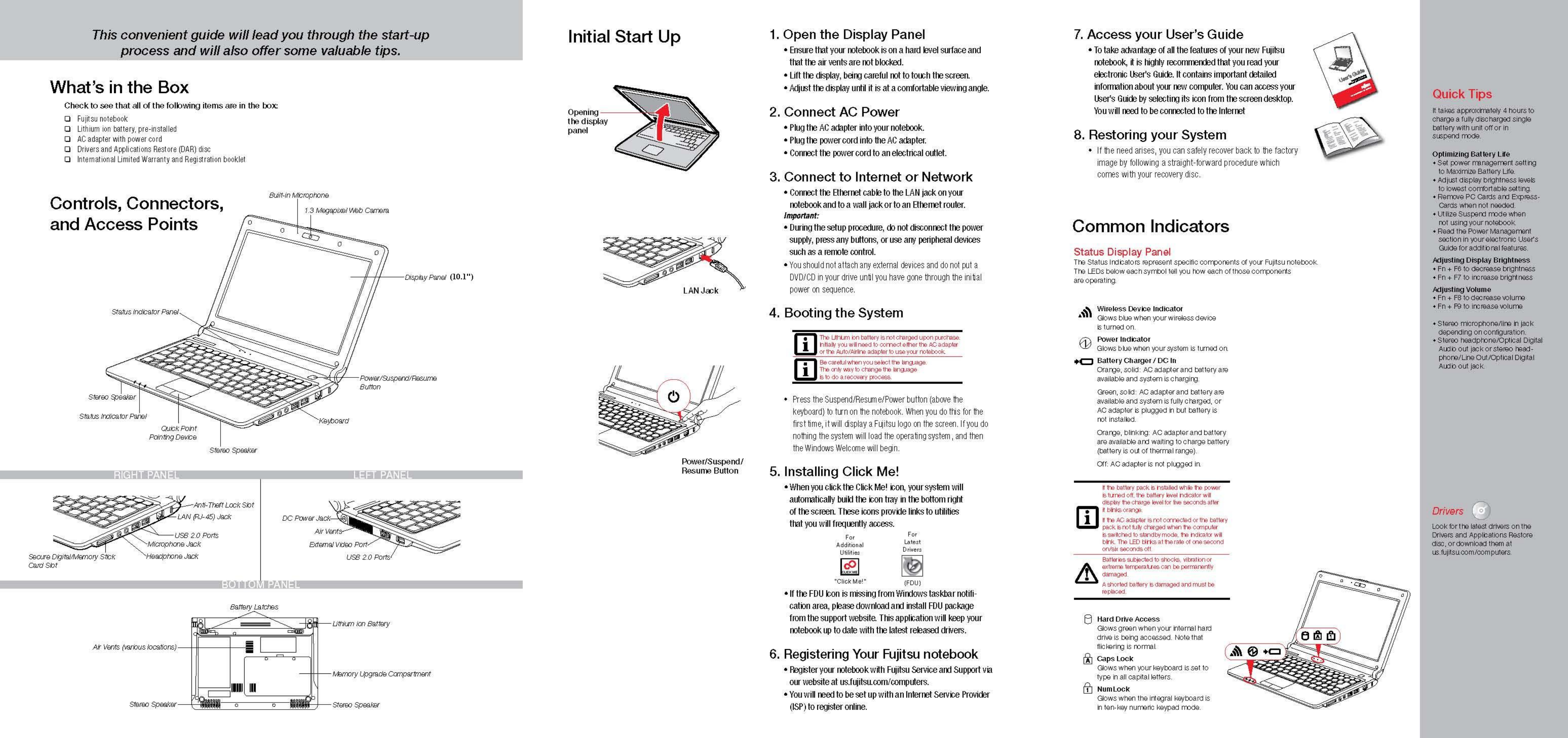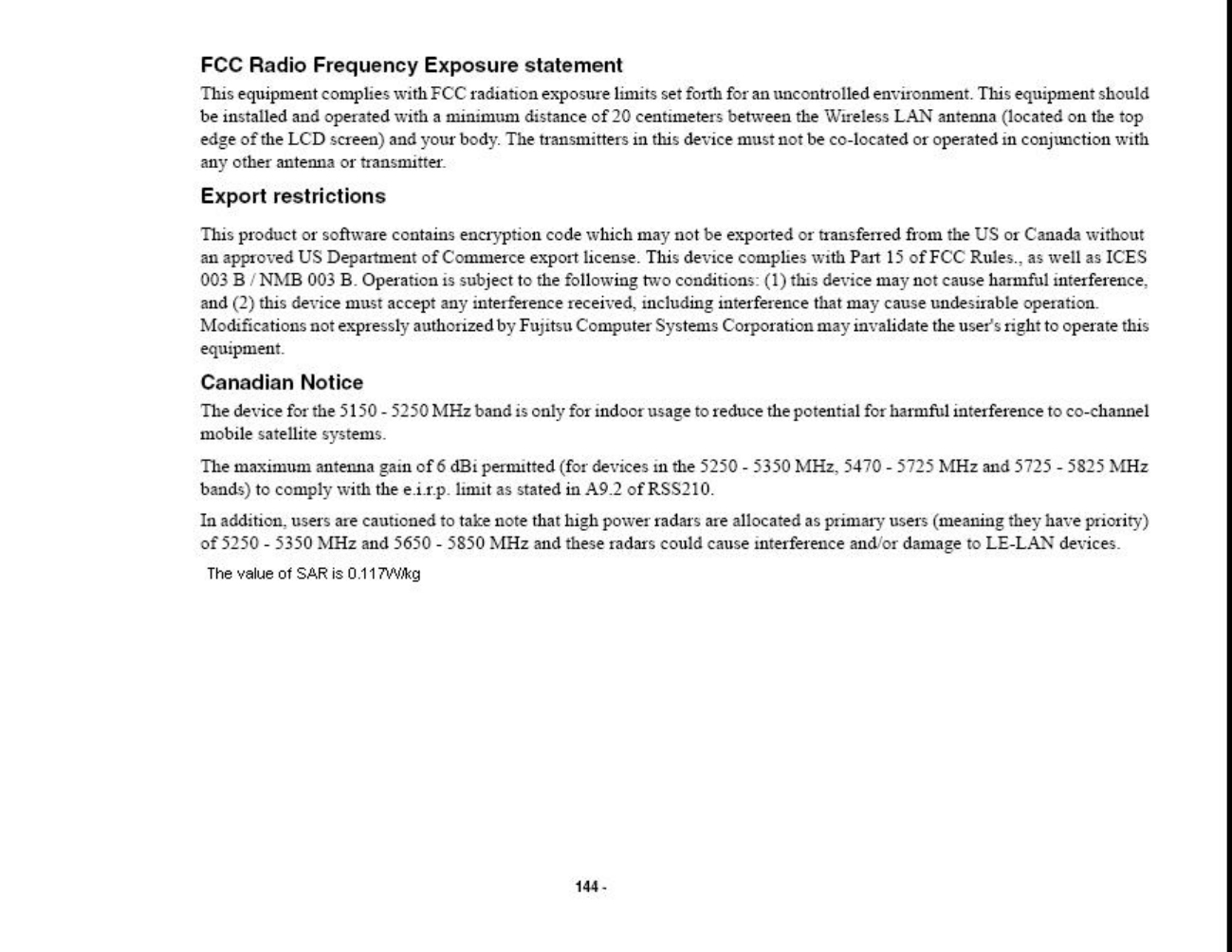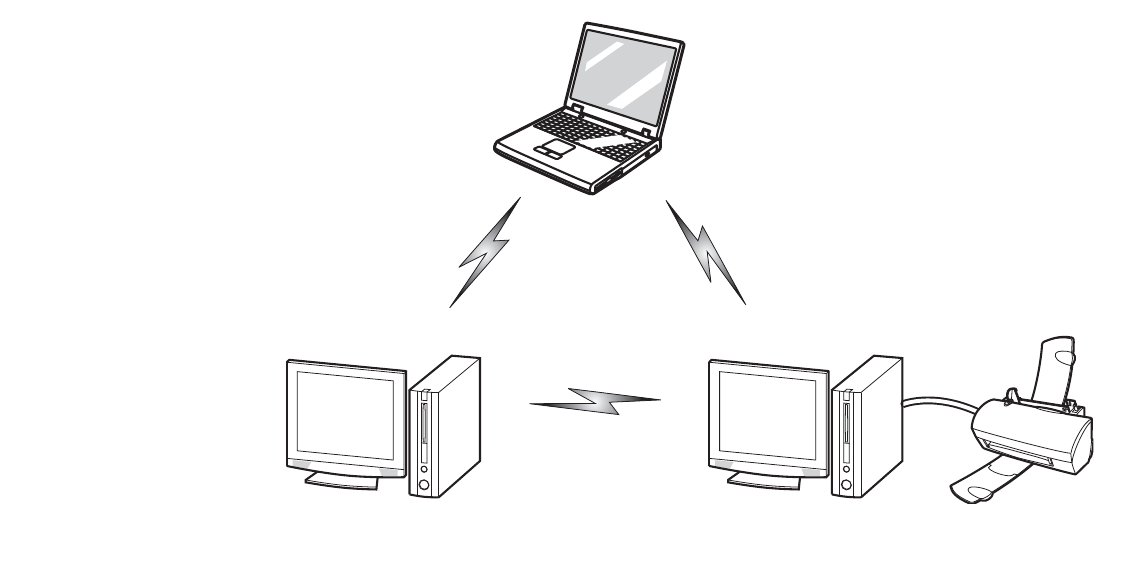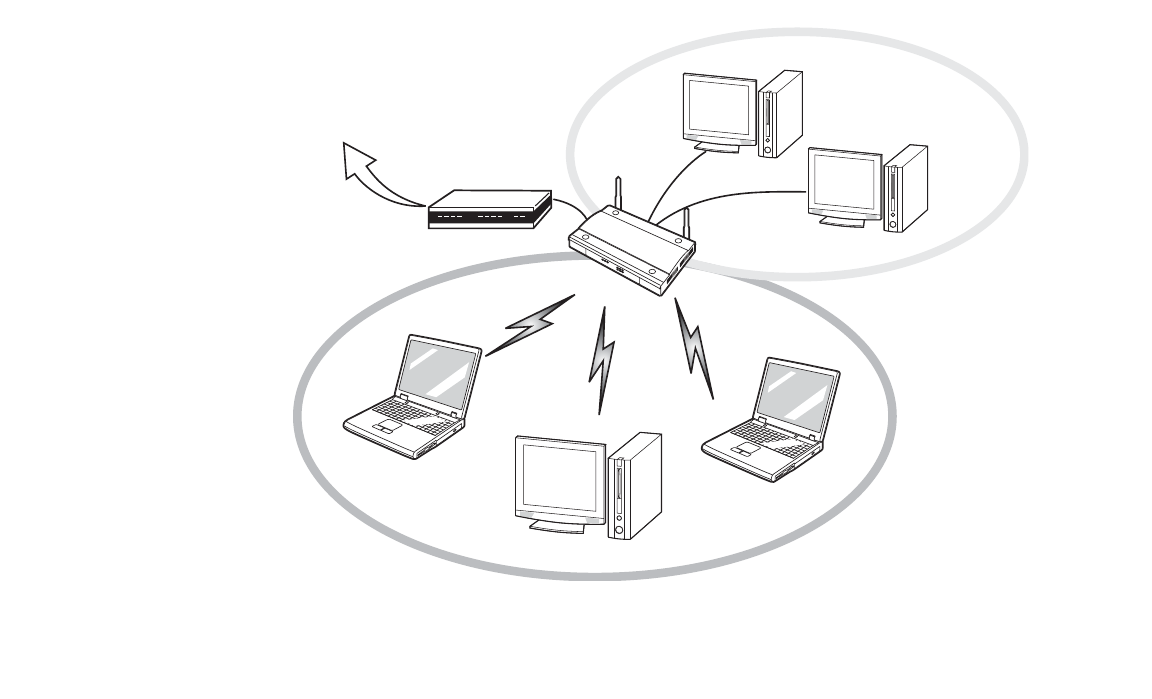Fujitsu Client Computing WB0074 NoteBook Computer User Manual
Fujitsu Limited NoteBook Computer
User Manual



User’s Guide
Learn how to use
your Fujitsu
M2010 notebook

137
- Regulatory Information
Regulatory Information
Notice
Changes or modifications not expressly approved by Fujitsu could void this user’s authority to operate the
equipment.
FCC NOTICES
Notice to Users of Radios and Television
This equipment has been tested and found to comply with the limit for class B digital devices, pursuant to
parts 15 of the FCC Rules.
These limits are designed to provide reasonable protection against harmful interference in a residential
installation. This equipment generates, uses, and can radiate radio frequency energy and, if not installed
and used in accordance with the instructions, may cause harmful interference to radio communications.
However, there is no guarantee that interference will not occur in a particular installation. If this
equipment does cause harmful interference to radio or television reception, which can be determined by
turning the equipment off and on, the user is encouraged to try to correct the interference by one or more
of the following measures:
•Reorient or relocate the receiving antenna.
•Increase the separation between the equipment and receiver.
•Connect the equipment into an outlet that is on a different circuit than the receiver.
•Consult the dealer or an experienced radio/TV technician for help.
Shielded interconnect cables must be employed with this equipment to ensure compliance with the
pertinent RF emission limits governing this device.

139
- Regulatory Information
DOC (INDUSTRY CANADA) NOTICES
Notice to Users of Radios and Television
This Class B digital apparatus meets all requirements of Canadian Interference-Causing Equipment
Regulations.
CET appareil numérique de la class B respecte toutes les exigence du Réglement sur le matérial brouilleur
du Canada.

142
Appendix A: WLAN User’s Guide
FCC Regulatory Information
Please note the following regulatory information related to the optional wireless LAN device.
Regulatory Notes and Statements
Wireless LAN, Health and Authorization for use
Radio frequency electromagnetic energy is emitted from Wireless LAN devices. The energy levels of these emissions, however,
are far much less than the electromagnetic energy emissions from wireless devices such as mobile phones. Wireless LAN
devices are safe for use by consumers because they operate within the guidelines found in radio frequency safety standards and
recommendations. The use of Wireless LAN devices may be restricted in some situations or environments, such as:
•On board an airplane, or
•In an explosive environment, or
•In situations where the interference risk to other devices or services is perceived or identified as harmful.
In cases in which the policy regarding use of Wireless LAN devices in specific environments is not clear (e.g., airports,
hospitals, chemical/oil/gas industrial plants, private buildings), obtain authorization to use these devices prior to operating the
equipment.

143
-
Regulatory Information/Disclaimers
Installation and use of this Wireless LAN device must be in strict accordance with the instructions included in the user
documentation provided with the product. Any changes or modifications made to this device that are not expressly approved
by the manufacturer may void the user’s authority to operate the equipment. The manufacturer is not responsible for any radio
or television interference caused by unauthorized modification of this device, or the substitution or attachment of connecting
cables and equipment other than those specified by the manufacturer. It is the responsibility of the user to correct any
interference caused by such unauthorized modification, substitution or attachment. The manufacturer and its authorized
resellers or distributors will assume no liability for any damage or violation of government regulations arising from failure to
comply with these guidelines.
This device must not be co-located or operated in conjunction with any other antenna or transmitter.
For IEEE 802.11a Wireless LAN: For operation within 5.15~5.25 GHz frequency range, it is restricted to indoor
environments, and the antenna of this device must be integral.
Federal Communications Commission statement
This device complies with Part 15 of FCC Rules.
Operation is subject to the following two conditions: (1) This device may not cause interference, and, (2) This device must
accept any interference, including interference that may cause undesired operation of this device.
FCC Interference Statement
This equipment has been tested and found to comply with the limits for a Class B digital device, pursuant to Part 15 of the FCC
Rules. These limits are designed to provide reasonable protection against harmful interference in a residential installation. This
equipment generates, uses, and can radiate radio frequency energy. If not installed and used in accordance with the instructions,
it may cause harmful interference to radio communications. However, there is no guarantee that interference will not occur in
a particular installation.
If this equipment does cause harmful interference to radio or television reception, which can be determined by turning the
equipment off and on, the user is encouraged to try and correct the interference by one or more of the following measures:
1Reorient or relocate the receiving antenna.
2Increase the distance between the equipment and the receiver.
3Connect the equipment to an outlet on a circuit different from the one the receiver is connected to.
4Consult the dealer or an experienced radio/TV technician for help.
Figure A-1. Ad Hoc Mode Network


145
- Before Using the Wireless LAN
Before Using the Wireless LAN
This manual describes the procedures required to properly setup and configure the optional integrated
Wireless LAN Mini Card device (referred to as “WLAN device” in the rest of the manual). Before using
the WLAN device, read this manual carefully to ensure it's correct operation.
Wireless LAN Devices Covered by this Document
This document is applicable to systems containing one of the following WLAN devices:
•Integrated Atheros AR5BHB63 (802.11 b/g)
Characteristics of the WLAN Device
•The WLAN device is a Mini-PCI card attached to the main board of the mobile computer.
•The WLAN device operates in license-free RF bands, eliminating the need to procure an FCC operating
license. The WLAN operates in the 2.4GHz Industrial, Scientific, and Medical (ISM) RF band and the lower,
middle.
•The WLAN device is capable of four operating modes, IEEE802.11b, IEEE802.11g.
•The WLAN device is Wi-Fi certified and operate (as applicable) at 54 Mbps in IEEE802.11g
mode; and 11 Mbps in IEEE802.11b mode.
•The WLAN device supports the following encryption methods - WEP, TKIP, CKIP, and AES encryption.
•The Wireless LAN device is compliant with the following standards: WPA, WPA2, CCX1.0, CCX2.0, CCX3.0,
and CCX4.0.

146
- Before Using the Wireless LAN
Wireless LAN Modes Using this Device
Ad Hoc Mode
“Ad Hoc Mode” refers to a wireless network architecture where wireless network connectivity between
multiple computers is established without a central wireless network device, typically known as Access
Point(s). Connectivity is accomplished using only client devices in a peer-to-peer fashion. That is why Ad
Hoc networks are also known as peer-to-peer networks. Ad Hoc networks are an easy and inexpensive
method for establishing network connectivity between multiple computers.
Ad Hoc mode requires that the SSID (service set identifier), network authentication, and encryption key
settings are identically configured on all computers in the Ad Hoc network.
Ad Hoc Mode Network

147
- Before Using the Wireless LAN
Access Point (Infrastructure) Mode
Infrastructure mode refers to a wireless network architecture in which devices communicate with wireless
or wired network devices by communicating through an Access Point. In infrastructure mode, wireless
devices can communicate with each other or with a wired network. Corporate wireless networks operate
in infrastructure mode because they require access to the wired LAN in order to access computers,
devices, and services such as file servers, printers, and databases.
Access Point (Infrastructure) Mode Network
ADSL modem,
cable modem,
or similar
Internet
Wired LAN
Access Point*
Wireless LAN
*An optional hub for a wired
LAN may be required depending
upon the type of access point used.

148
- Before Using the Wireless LAN
How to Handle This Device
The WLAN device is an optional device that may come pre-installed in your mobile computer. Under
normal circumstances, it should not be necessary for you to remove or re-install it. The Operating System
that your mobile computer comes with has been pre-configured to support the WLAN device.
Wireless Network Considerations
•The WLAN device supports IEEE802.11b and IEEE802.11g.
•The WLAN device operates in the 2.4 GHz ISM band.
•Microwave ovens may interfere with the operation of WLAN devices since they operate in the same 2.4 GHz
frequency range as IEEE802.11b/g devices.
•Wireless devices that transmit in the 2.4 GHz range may interfere with operation of WLAN devices in
IEEE802.11b/g modes. Symptoms of interference include reduced throughput, intermittent disconnects,
and many frame errors. It is HIGHLY recommended that these interfering devices be powered off to ensure
proper operation of the WLAN device.
Deactivating the WLAN Device
Disconnecting the WLAN device may be desired in certain circumstances (to extend battery life) or where
certain environments require it (i.e., hospitals, clinics, airplanes, etc.). The WLAN device can be
deactivated by using the Wireless On/Off key (Fn+F2), and it can be disconnected in Windows using the
WLAN icon in the system tray (Note that disconnecting via the icon in the system tray does not turn off the radio;
it continues to transmit and receive even though it’s not connected.).
BEFORE USING THE WIRELESS LAN DEVICE, YOU MUST FIRST INSTALL CLICKME! TO ENSURE THAT THE
CORRECT SOFTWARE FOR YOUR DEVICE IS INSTALLED. SEE SEE “INSTALLING CLICK ME!” ON PAGE 45.

149
- Before Using the Wireless LAN
Disconnection Using the Icon in the Taskbar
Note that disconnecting via the icon in the system tray does not turn off the radio; it continues to transmit
and receive even though it’s not connected.
1Right-click the WLAN icon in the taskbar at the bottom right of your screen.
2Choose Disconnect from a network.
Activating the WLAN Device
Activation of the WLAN device can be accomplished using the same methods as the deactivation process
•Using the Wireless On/Off Key
•In Windows, by right-clicking the WLAN icon then clicking “Connect to a network”
Deactivation using the
Wireless LAN/Bluetooth
On/Off Key (Fn + F2)
The WLAN device can be
deactivated quickly and efficiently
by toggling the Wireless
LAN/Bluetooth On/Off Key to
the Off position.
Wireless LAN/Bluetooth
On/Off Switch

150
- Configuration of the WLAN Device
Configuration of the WLAN Device
The optional WLAN device can be configured to establish wireless network connectivity using the
software that is built into Windows Vista. Support for most industry standard security solutions is
contained in this software.
Pre-defined parameters will be required for this procedure. Please consult with your network
administrator for these parameters:
Configuring the WLAN Using Windows Vista
1Click the Start button, then select Control Panel.
2If the Control Panel is not in Classic View, select Classic View from the left panel. Double-click the Network and
Sharing Center icon.
3Select “Manage wireless networks” from the left panel.
4Click on the [Add] button.
5Depending upon what type of connection you would like to make, make a selection. For an infrastructure
network, select “Manually create a network profile. For ad hoc network, select “Create an ad hoc network”.
6Enter the required information. It may be necessary to consult with your network administrator for some of the
information.
7In the event you require assistance, go to the Network and Sharing Center window (Start -> Control Panel ->
Network and Sharing Center), and type in relevant keywords in the Search box.
Connecting to a Network
After you have configured your computer, you can connect to an active network by performing the
following steps:
1Click on the WLAN icon in the system tray.
2Select “Connect to a network”.
3Select a network from the list that appears, and click the [Connect] button.

151
- Configuration of the WLAN Device
Connection to the network
After you have configured your computer, you can connect to an active network by clicking on the
Wireless Network icon in the system tray:

152
- Troubleshooting the WLAN
Troubleshooting the WLAN
Troubleshooting Table
Causes and countermeasures for troubles you may encounter while using your wireless LAN are described
in the following table.
Problem Possible Cause Possible Solution
Unavailable
network
connection
Incorrect network name
(SSID) or network key
Ad hoc connection: verify that the network names (SSID’s)
and network keys (WEP) of all computers to be connected
have been configured correctly. SSID’s and WEP key values
must be identical on each machine.
Access Point (Infrastructure) connection: set the network
name (SSID) and network key to the same values as those of
the access point.
Set the Network Authentication value identically to that of the
Access Point. Please consult your network administrator for
this value, if necessary.
Weak received signal
strength and/or link
quality
Ad hoc connection: Retry connection after shortening the
distance to the destination computer or removing any
obstacles for better sight.
Access Point (Infrastructure) connection: Retry connection
after shortening the distance to the access point or removing
any obstacles for better sight.

153
- Troubleshooting the WLAN
Unavailable
network
connection
(continued)
The WLAN device has
been deactivated or
disabled
Check if the wireless key is turned ON. Also verify “Disable
Radio” is not checked in “Network setting” window.
The computer to be
connected is turned off
Check if the computer to be connected is turned ON.
RF interference from
Access Points or other
wireless networks
The use of identical or overlapping RF channels can cause
interference with the operation of the WLAN device. Change
the channel of your Access Point to a channel that does not
overlap with the interfering device.
Wireless network
authentication has
failed
Re-check your Network Authentication, Encryption, and
Security settings. Incorrectly configured security settings such
as an incorrectly typed WEP key, a misconfigured LEAP
username, or an incorrectly chosen authentication method will
cause the LAN device to associate but not authenticate to the
wireless network.
Incorrectly configured
network settings
Recheck the configuration of your network settings.
Incorrect IP address
configuration
This only applies to networks using static IP addresses. Please
contact your network administrator for the correct settings.
Problem Possible Cause Possible Solution

154
- Troubleshooting the WLAN
WLAN Specifications
Item Specification
Type of network The integrated Wireless LAN (802.11 b/g), Wi Fi based*.
Transfer rate (Automatic switching) 54 Mbps maximum data rate
Active frequency
•802.11b/g: 2400~2473 MHz
Number of channels
•802.11b/g: 11 channels, 3 non-overlapping channels
Typical operating distances**
•802.11b: 100 ft. (30 m) @ 11 Mbps; 300 ft. (91 m) @ 1 Mbps
•802.11g: 100 ft. (30 m) @ 54 Mbps; 300 ft. (91 m) @ 1 Mbps
Security •Encryption Types - WEP, TKIP, AES***, WPA 1.0, WPA2,CCX compliant
Encryption Key lengths Supported: 64 bits and 128 bits 802.1x/EAP
Maximum recommended number
of computers to be connected over
wireless LAN (during ad hoc
connection)
10 units or less ****

155
- Troubleshooting the WLAN
*
“Wi-Fi based” indicates that the interconnectivity test of the organization which guarantees the
interconnectivity of wireless LAN (Wi-Fi Alliance) has been passed.
**
The communication ranges shown above will increase or decrease depending on factors such as
number of walls, reflective material, or interference from external RF sources.
***
Encryption with network key (WEP) is performed using the above number of bits, however, users
can set 40 bits/104 bits after subtracting the fixed length of 24 bits.
****
Depending on practical environments, the allowable number of computers to be connected may be
decreased.

156
- Using the Bluetooth Device
Using the Bluetooth Device
The Integrated Bluetooth module (QBTM400) is an optional device available for Fujitsu mobile
computers.
What is Bluetooth?
Bluetooth technology is designed as a short-range wireless link between mobile devices, such as laptop
computers, phones, printers, and cameras. Bluetooth technology is used to create Personal Area Networks
(PANs) between devices in short-range of each other.
Where to Find Information About Bluetooth
The Bluetooth module contains a robust Help user’s guide to assist you in learning about operation of the
Bluetooth device.
To access the Help file, click [Start] > All Programs, and click on Bluetooth, then select User’s Guide.
For additional information about Bluetooth Technology, visit the Bluetooth Web site at:
www.bluetooth.com.
THE WIRELESS LAN/BLUETOOTH ON/OFF Key WILL POWER OFF BOTH THE OPTIONAL WIRELESS
LAN AND BLUETOOTH DEVICES AT THE SAME TIME. TO ENABLE OR DISABLE EITHER ONE OF THE
DEVICES INDIVIDUALLY, PERFORM THE FOLLOWING STEPS:
1 Press 'Fn and 'F2 key on the keyboard.
2Go to Start > All Programs > Bluetooth.
3Click on Options under the Bluetooth menu and click on the Bluetooth Radio Power
button.
4Click [OK].

157
- Using the Bluetooth Device
FCC Radiation Exposure Statement
This equipment complies with FCC radiation exposure limits set forth for an uncontrolled environment.
The Bluetooth antenna is located on the front edge of the right palm rest and is exempt from minimum
distance criteria due to its low power.
The transmitters in this device must not be co-located or operated in conjunction with any other antenna
or transmitter.
Canadian Notice
To prevent radio interference to the licensed service, this device is intended to be operated indoors and
away from windows to provide maximum shielding. Equipment (or its transmit antenna) that is installed
outdoors is subject to licensing.
Warranty
Users are not authorized to modify this product. Any modifications invalidate the warranty.
This equipment may not be modified, altered, or changed in any way without signed written permission
from Fujitsu. Unauthorized modification will void the equipment authorization from the FCC and
Industry Canada and the warranty.